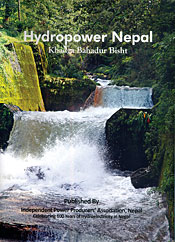 Hydropower Nepal IPPAN, 2010 ISBN: 978-9937-2-2732-2 Pages: 293 |
Flipping though Khadga Bahadur Bisht's book celebrating the centenary of electricity in Nepal by candlelight this week, the absurdity of it all suddenly dawned on me. It also demonstrated how inured we have become to power cuts.
Crippling 14-hour power cuts in a country with among the highest per capita hydroelectricity generation potential in the world are an indication of shameless malgovernance, and just how completely our rulers have let us down since 1990.
Bisht is with the Independent Power Producers' Association of Nepal, which published the book, 'Hydropower Nepal', to mark 100 years since the commissioning of the 500kW Pharping power plant in 1911. In hindsight, the fact that Nepal was generating electric power for streetlights even before the UK had established a national grid could be considered something of an achievement. 100 years later, few of Kathmandu's streetlights work even when there is power.
'Hydropower Nepal' is a useful reference tool for the past, present and future of hydropower development in Nepal with a glossary of rivers, hydropower plants and a wishlist of projects.
Domestic political squabbling among political parties contributed to the current power crisis. After Prime Minister Girija Prasad Koirala signed the Mahakali Treaty with India in 1996 Bisht says, UML mounted a nationalist campaign and overthrew him, but UML itself split when it went ahead and ratified the treaty.
Bisht lists other reasons for the power famine: fecklessness and political interference at the Nepal Electricity Authority, delays due to the conflict, the state's negative attitude towards private producers, low tariffs and dollar-denominated deals. The book cites the World Bank's withdrawal from the Arun III project in 1995 as the watershed that precipitated the loadshedding crisis. But some Arun slayer activists would probably argue that Arun was the wrong project at the wrong time and more power was generated by cheaper, medium-sized plants in the ten years after it was scrapped.
Over reliance on run-of-the-river schemes is another reason. Water flow in rivers is lowest when demand is highest, and the only way to get out of that trap is to build storage reservoirs to tide over peak winter and evening demand. It may be wise to turn West Seti into a domestic project, for example.
Whatever the merits of the case, it is clear that the country cannot sustain the current peak load shortfall of 400MW that is surely going to increase. The book estimates that the country loses $1 billion a year due to loss of industrial production and cost of diesel generation. Bisht says: "To say this is simply a failure is an understatement �it is in fact a huge disaster."
The power crisis also masks other systemic failures and instances of poor decision-making that have resulted in the power-starved Nepali public having to fork out billions of rupees to pay contractors for cost over-runs because politicians pocketed kickbacks to get NEA to approve faulty FIDIC contracts for projects like Kali Gandaki A. The unending West Seti saga is another example of the result of political failure and lack of national focus.
So, what to do? The Pushpa Kamal Dahal government set out a goal of generating 10,000MW in ten years, and the Madhav Kumar Nepal government that replaced him was even more ambitious in aiming for 25,000MW in 20 years. A task force set up to look at power scenarios says it is possible to generate 2,000MW by 2014 through power projects for domestic consumption, another 10,000MW by 2024 through a combination of run-of-the-river and storage projects, and 18,000MW by 2029 through export multi-purpose mega projects like Karnali and Kosi.
At the end of his book, Bisht looks forward to 'a new hydropower century' for Nepal. Let's hope it will be brighter than the last.
Kunda Dixit
READ ALSO:
No light at the end of the tunnel, DEWAN RAI and RUBEENA MAHATO


